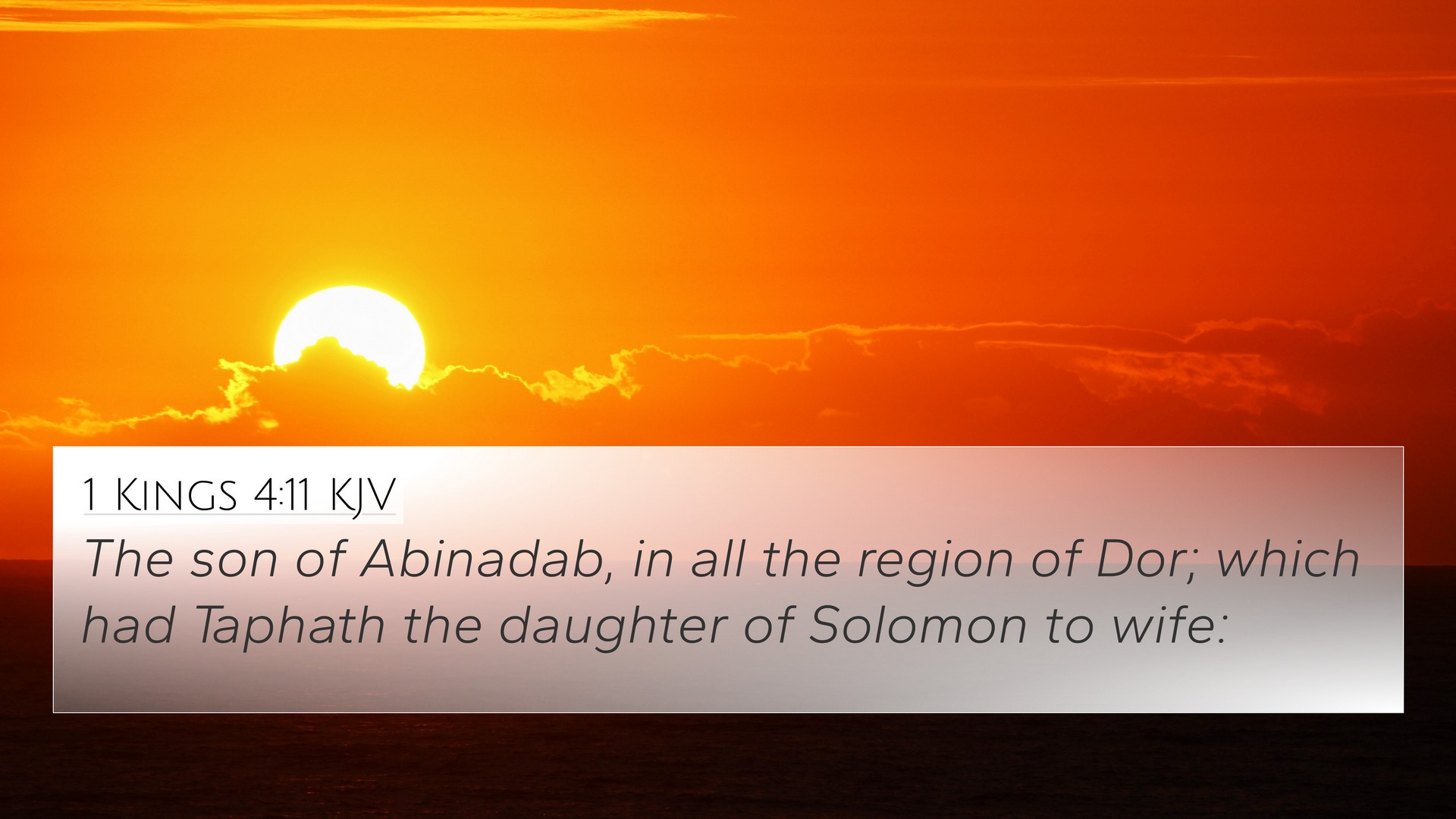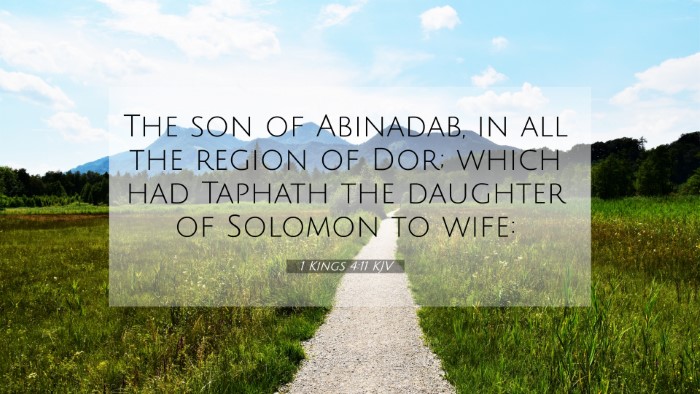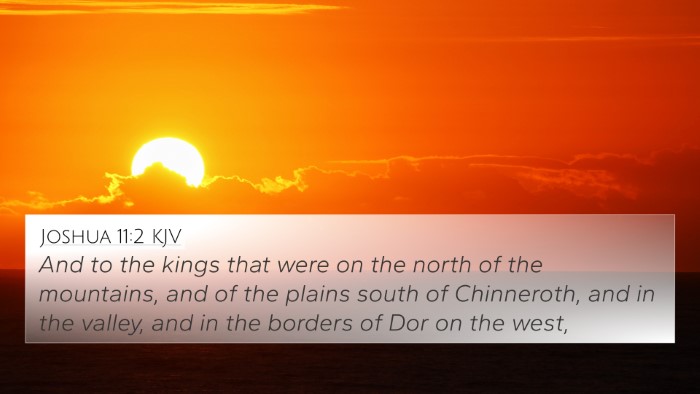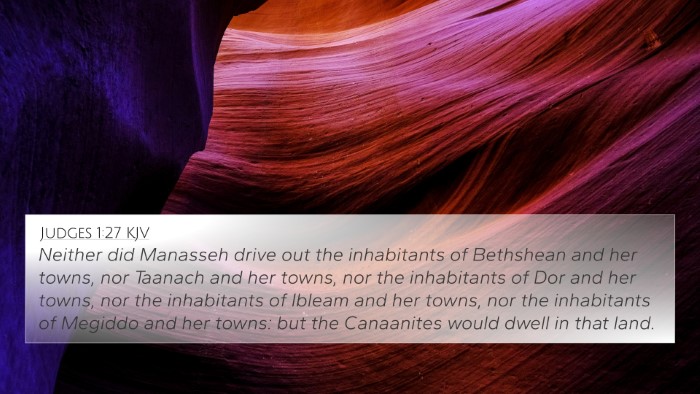Understanding 1 Kings 4:11
1 Kings 4:11 reads: "The son of Abinadab, in all the region of Dor; and he had Taphath the daughter of Solomon to wife."
This verse highlights the administrative organization of King Solomon's government and provides insight into the personal connections that played a role in political alliances during his reign. The inclusion of family ties suggests the fusion of familial relationships with political governance.
Commentary Insights
The reflections of notable public domain commentators help illustrate the complexities of this verse:
-
Matthew Henry:
Henry emphasizes that Solomon's reign was characterized by wisdom and connections that extended beyond mere politics. His mentioning of Abinadab's son suggests a governance model that balances friendship and responsibility. The mention of Taphath, Solomon’s daughter, highlights the intertwining of family and governance.
-
Albert Barnes:
Barnes elucidates that the phrasing indicates a structured governmental system where men were appointed to oversee various regions. The marriage connection implies a fortified alliance which reflects typical diplomatic strategies of the time, reinforcing ties through marriage.
-
Adam Clarke:
Clarke notes the significance of the region of Dor, tying it to the greater context of Israel’s administrative divisions. He also reflects on how personal relationships demonstrated in governance could lead to stability or instability in a kingdom's rule.
Thematic Connections and Inter-Biblical Dialogue
This verse serves as a gateway to understand the broader themes of governance, familial bonds in leadership, and political alliances in the Bible. There are several key connections to other scripture that explore related themes:
- Solomon's Wisdom: 1 Kings 3:5-14 - Here, Solomon's request for wisdom to govern is contrasted with the practical applications of that wisdom in his administration.
- Family Ties: Genesis 24:3-4 - Abraham's instructions to secure a wife for Isaac from his own kindred start a theme of political and familial alignment.
- Political Alliances: 1 Kings 11:1-4 - Solomon’s later marriages demonstrate how such ties can lead to spiritual failure and political strife.
- Qualifications for Leadership: Exodus 18:21-22 - Moses' advice on choosing leaders emphasizes the importance of wisdom, understanding, and family loyalty in governance.
- Children in Leadership: Proverbs 17:6 - This verse underscores the significance of family and descendants in the larger context of leadership in Israel.
- Regional Governance: Matthew 25:21 - The parable of the talents where stewardship leads to affirmation highlights the importance of wise administration.
- The Role of Daughters: Proverbs 31:10-31 - The virtuous woman is celebrated, drawing connections back to valuing familial relations in the wider cultural construct.
Practical Applications
The insights gained from 1 Kings 4:11 can be reflected in various ways:
- Understanding Governance: Recognize the importance of political alliances and wisdom in leadership roles today.
- Family in Leadership: Reflect on how family connections can influence leadership dynamics within communities.
- Cross-Referencing Biblical Texts: Utilize tools like a Bible concordance or a cross-reference guide for deeper understanding of Biblical narratives.
Cross-Referencing and Study Tools
For those interested in cross-referencing Biblical texts, utilizing a comprehensive Bible cross-reference system can enhance study and understanding:
- Identify connections between Old and New Testament passages.
- Engage in cross-reference Bible study methods to draw thematic parallels.
- Leverage resources such as a Bible reference guide to locate related scriptures easily.
Conclusion
1 Kings 4:11 not only sheds light on King Solomon's structure of governance but also opens discussions on the intertwining of familial and political dynamics in leadership roles. The insights from classical commentary, along with strategic cross-referencing, amplify the understanding of this verse's significance in Biblical narrative. As we explore these connections, we recognize the timeless relevance of the themes presented in this verse within both ancient and contemporary contexts.






